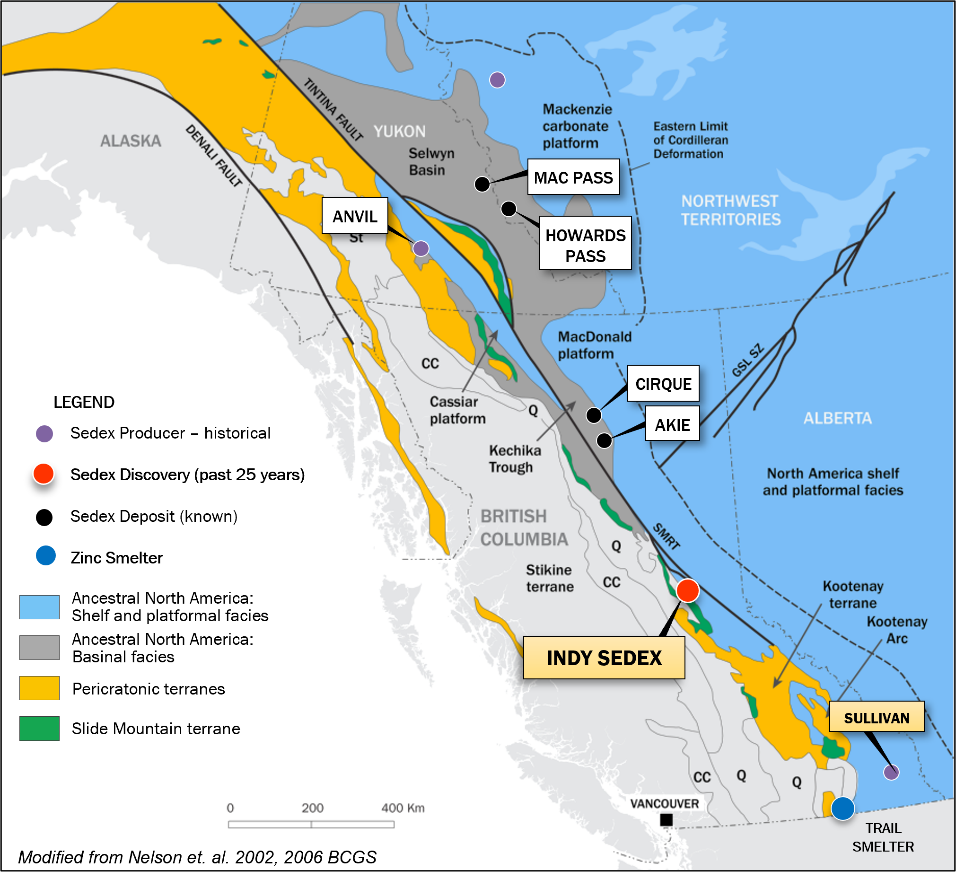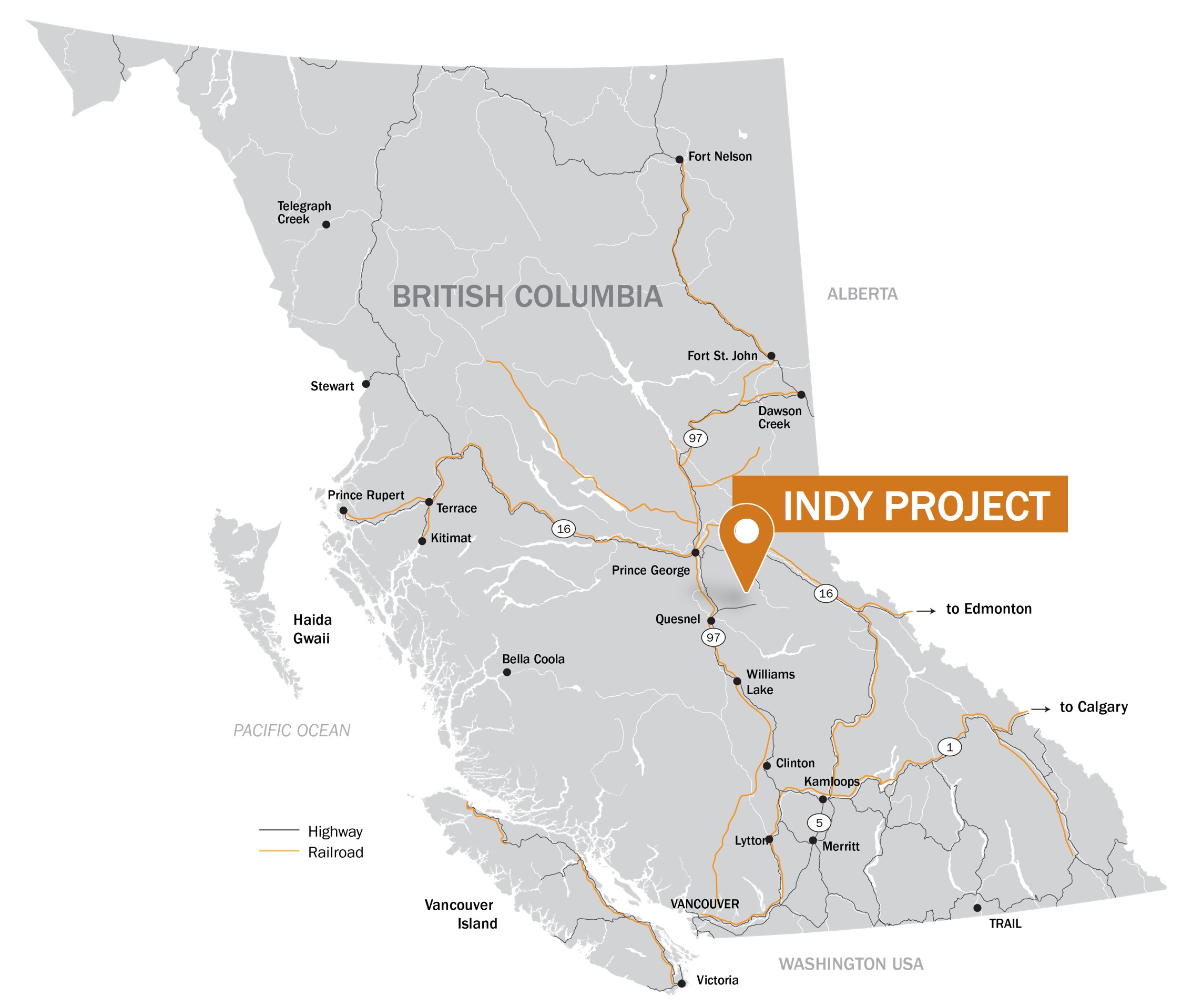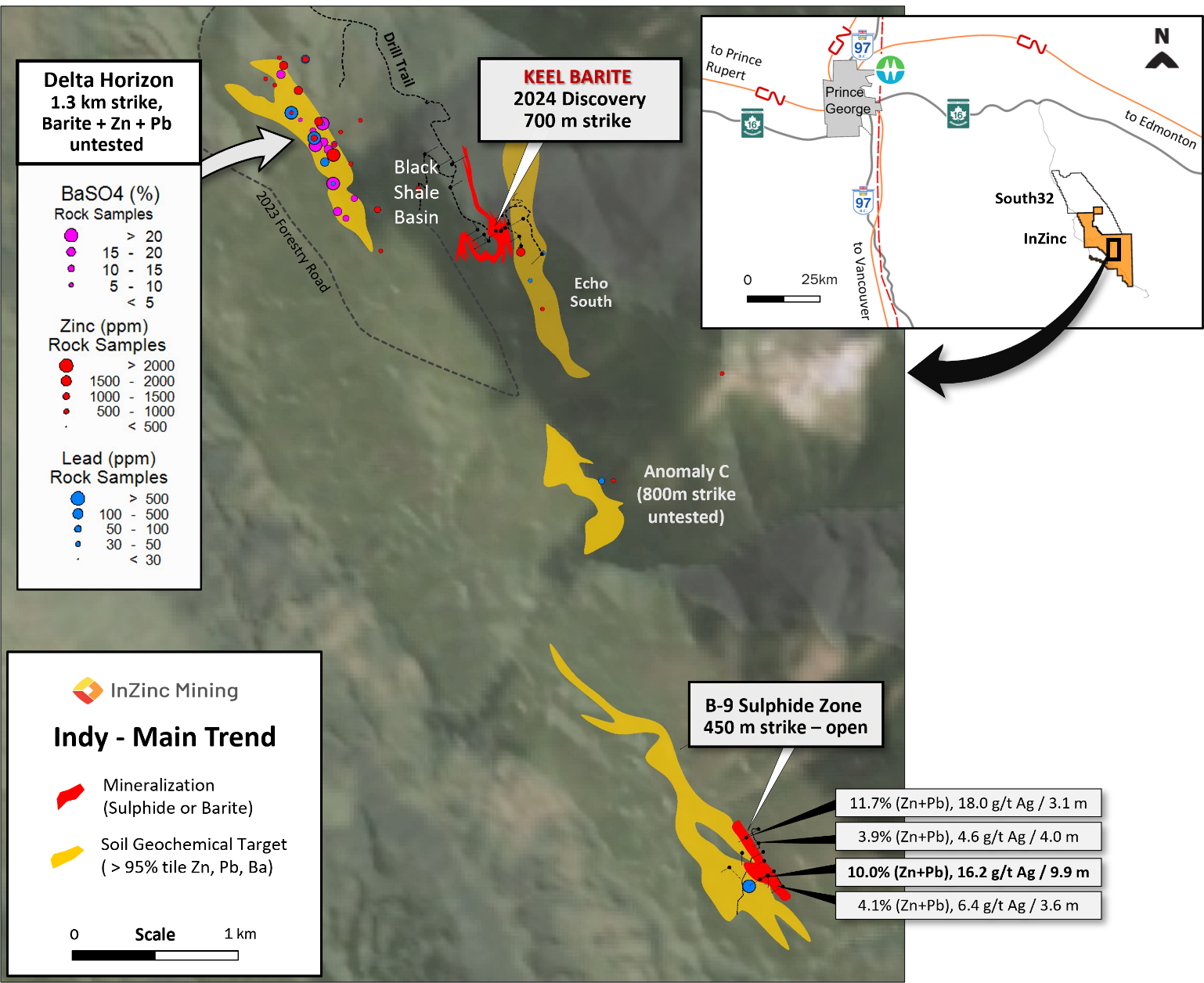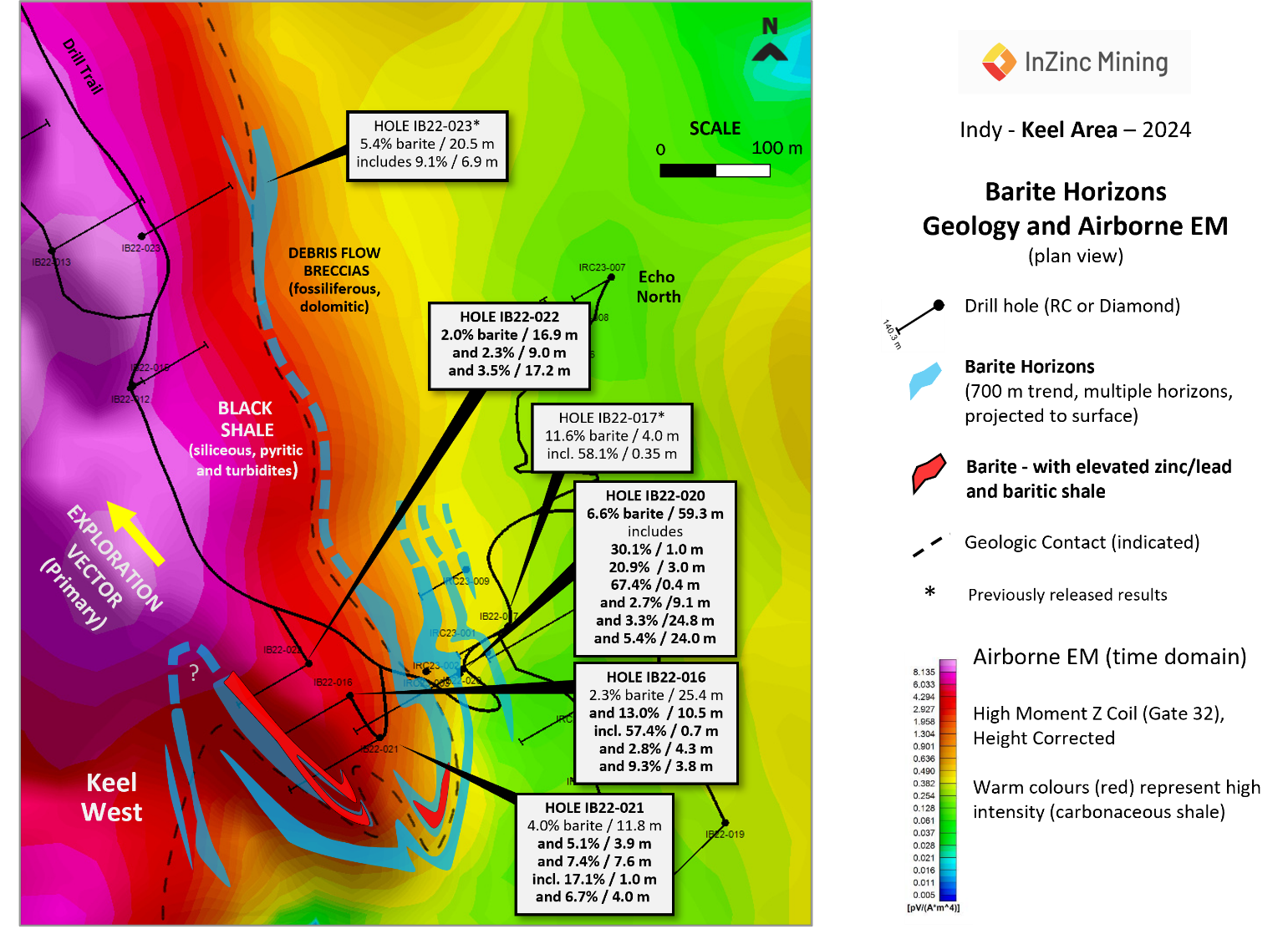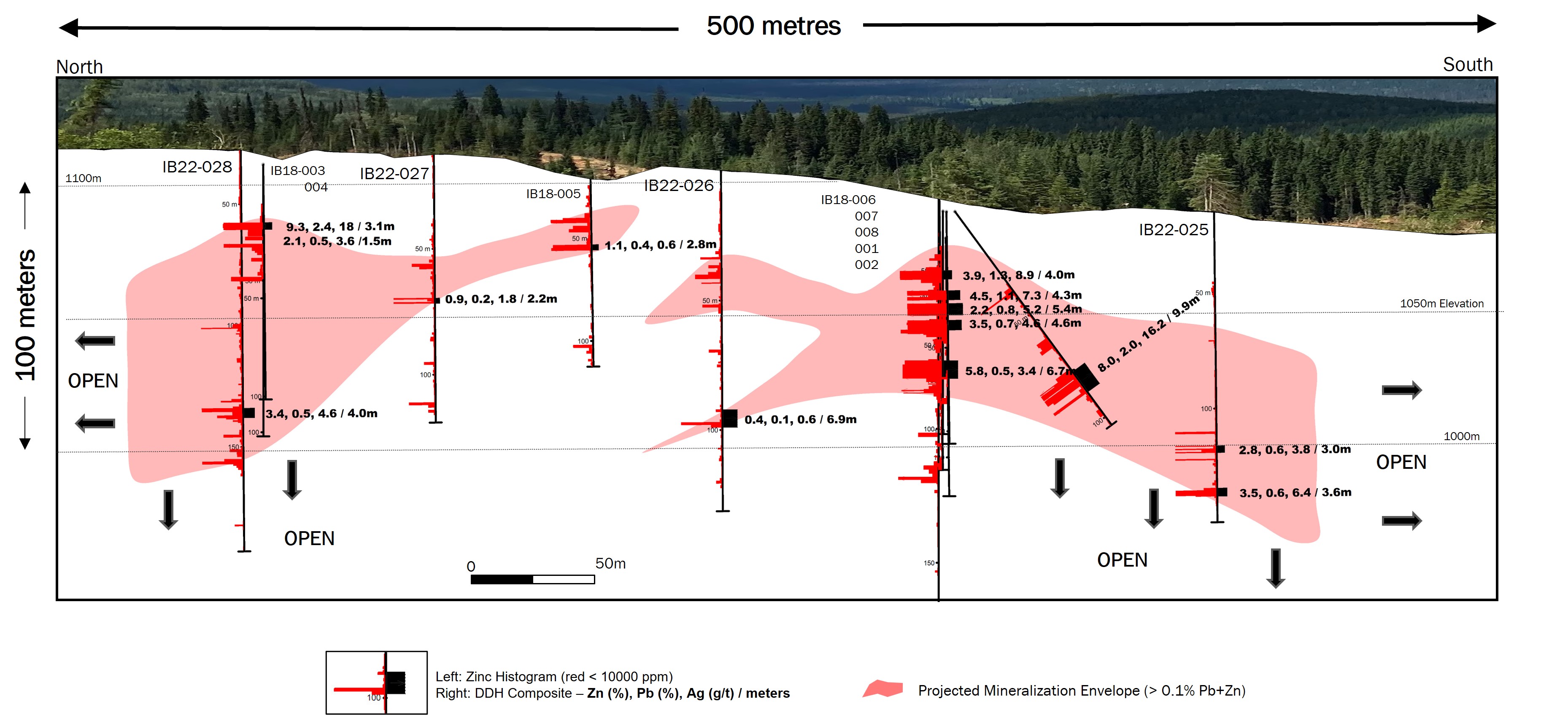I agree to and consent to receive news, updates, and other communications by way of commercial electronic messages (including email) from InZinc Mining. I understand I may withdraw consent at any time by clicking the unsubscribe link contained in all emails from InZinc Mining.
Bringing the North to the South – A New and Accessible Canadian Mineral Belt
Discovery of the Prolific Selwyn Basin in Central BC in 2024
- One of the world’s most prolific Sedex (zinc-lead-silver) belts, the Selwyn Basin, is confirmed at Indy in 2024 – 500 km south of the previously known extent
- Widespread, high grade barite mineralization is discovered at Keel – an important component and common pathfinder of Sedex deposits in the Selwyn Basin
- Sedex style (zinc-lead-silver) sulphide mineralization, open for expansion, located 4 km south of Keel
Western Canadian Sedex (Zinc-Lead-Silver) Deposits of the Selwyn Basin
Selwyn Basin – World Class Sedex Discoveries in the Yukon and Northeast BC
Sedex Districts and Deposits of the Selwyn Basin
| Sedex Deposit/District | Historical and Current Estimates* | |
| Tonnage (Mt) | Grade | |
| Anvil District, Yukon | 120 | 5.6% Zn, 3.7% Pb and 45 to 50 g/t Ag |
| Howard’s Pass District, Yukon | 400 | 5% Zn and 2% Pb |
| Mac Pass District, Yukon | 11.2 Indicated 39.5 Inferred |
6.6% Zn, 2.5% Pb and 21.3 g/t Ag 5.8% Zn, 3.1% Pb and 38.2 g/t Ag |
| Cirque, Northeast BC | 40 | 7.8% Zn, 2.2% Pb and 48 g/t Ag |
| Akie, Northeast BC | 22.7 Indicated 7.5 Inferred |
8.3% Zn, 1.6% Pb and 14.1 g/t Ag 7.0% Zn, 1.2% Pb and 12.0 g/t Ag |
Easy Access – Excellent Infrastructure
The project is located 90 km southeast of the city of Prince George, the major hub for transportation and heavy industry in central British Columbia. Indy is about a 1.5-hour drive from Prince George.
The project is accessed via 70 km of forestry road from the Yellowhead Highway (Hwy 16). It is located 85 km from the intercontinental Canadian National Railway (CNR), servicing the Port of Prince Rupert and connecting to the Port of Vancouver, and 35 km from hydro-electric transmission lines.
Indy in Central British Columbia
District Scale Tenure – A Major Presence
The mineral claims extend over a continuous 30 km (200 km2) trend comprised of unexplored mineral showings and large soil geochemistry anomalies within rocks with a known affinity for hosting large base and precious metal deposits.
South32 (ASX, LSE, JSE), a global mining and metal producer, independently staked 200 km2 of mineral claims northwest of Indy in late 2021 and renewed the claims in late 2023.
District Scale Tenure
Discoveries of Barite and Zinc-Lead-Silver Mineralization
Exploration programs have identified multiple and extensive trends including barite and Sedex type (zinc-lead-silver) mineralization along the 7 km Main Trend area. Exploration continues to refine targets in the Main Trend and expand outwards across the remaining 23 km of the unexplored property.
Barite mineralization is present in many, if not all, of the large Sedex deposits in North America – especially at the deposits of the Selwyn basin. At Indy, extensive barite mineralization (700 m trend, discovered 2024) is outlined by drilling at Keel, with local enrichment of zinc-lead at Keel West. Widespread barite (1 km trend), with local zinc-lead enrichment, is also known in numerous surface rock samples at the Delta Horizon, located 1 km northwest of Keel.
Sedex-style zinc-lead-silver mineralization (shallow drilling, open for expansion) is present at the B-9 Zone, located 4 km south of Keel.
Main Trend Mineralization and Targets
- To date, 27 of 37 drill holes completed across the Main Trend have intersected mineralization with either sulphide (zinc-lead-silver) or barite present
Keel Barite Discovery Provides New Exploration Vectors for Sedex Deposits
The location and distribution of barite provides new, high potential exploration vectors for potential large Sedex (zinc-lead-silver) deposits.
Extensive high grade barite mineralization, over 700 m in strike length, was discovered in 2024 by drilling at Keel. Four barite horizons are identified – each may represent a potential Sedex horizon along trend.
Keel Area – Barite Horizons, Geology and Airborne EM
Zinc Discovery and Expansion at B-9 Zone
Strong mineralization was discovered at less than 60 m depth at Anomaly B in the 2018 drill program. Nine of 10 holes intersected shallow mineralization across a 350 m trend, named the B-9 Zone.
2018 Discovery Drilling at B-9 Zone
The shallow, wide spaced 2022 drill program explored along a 450 m trend to 130 m at depth, with 4 of 5 holes intersecting shallow mineralization. The drilling demonstrates both continuity and expansion potential of near surface mineralization. Mineralization remains open for expansion to the north, south and at depth.
Geophysical and geochemical surveys indicate stratigraphy hosting B-9 continues well beyond the current area of exploration drilling.
B-9 Zone – Shallow Mineralization is Open for Expansion in All Directions
Vertical Long Section
*References – Sedex Districts and Deposits of the Selwyn Basin
Anvil District, Yukon – Emsbo, P., U.S. Geological Survey, in SEG Reviews, Vol. 13, 2000, p. 427-437.
Howard’s Pass District, Yukon – Goodfellow, W.D., Lydon J.W., and Turner R.J.W., 1993. Geology and genesis of stratiform sediment-hosted (SEDEX) zinc-lead-silver sulphide deposits; in Mineral Deposit Modeling, (ed.) R.V. Kirkham, W.D. Sinclair, R.I. Thorpe, and J.M. Duke; Geological Association of Canada: Special Paper 40, p. 201-251.
Mac Pass District, Yukon – Fireweed Metals, website.
Cirque, Northeast BC – Don G. MacIntyre, Ph.D., P.Eng, BCGS 1998. Geology, Geochemistry and Mineral Deposits of the Akie River Area, Northeast British Columbia.
Akie, Northeast BC – ZincX Resources, website.
